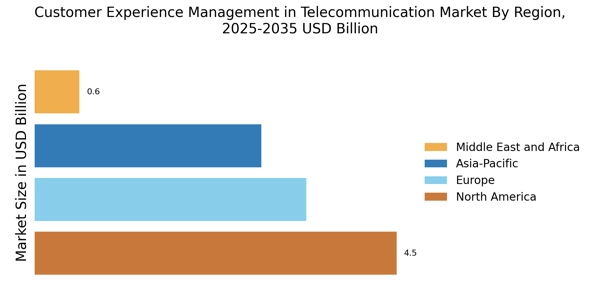Competitive Pressure
The competitive landscape in the Customer Experience Management CEM in Telecommunication Market is intensifying, prompting companies to innovate and enhance their service offerings. With numerous players vying for market share, differentiation through superior customer experience has become paramount. Companies are increasingly adopting strategies that focus on customer-centricity, aiming to provide exceptional service and support. This competitive pressure is driving investments in technology and training, as organizations seek to equip their staff with the skills necessary to deliver outstanding customer experiences. Furthermore, the rise of new entrants and alternative service providers is compelling established companies to rethink their customer engagement strategies. As competition continues to escalate, the emphasis on delivering exceptional customer experiences will likely remain a key driver in the Customer Experience Management CEM in Telecommunication Market.
Regulatory Compliance
Regulatory compliance is a significant driver in the Customer Experience Management CEM in Telecommunication Market. Telecommunications companies are required to adhere to various regulations concerning data privacy and consumer protection. Compliance with these regulations not only mitigates legal risks but also fosters trust among customers. For instance, the implementation of the General Data Protection Regulation (GDPR) has compelled companies to enhance their data handling practices. This shift towards greater transparency and accountability is likely to improve customer perceptions and experiences. Moreover, companies that prioritize compliance are often viewed more favorably by consumers, which can lead to increased customer retention. As regulatory frameworks continue to evolve, the focus on compliance will remain a critical aspect of Customer Experience Management CEM in Telecommunication Market.
Technological Advancements
The rapid evolution of technology plays a pivotal role in shaping the Customer Experience Management CEM in Telecommunication Market. Innovations such as 5G networks and artificial intelligence are enhancing service delivery and customer interactions. For instance, the deployment of 5G technology is expected to improve data speeds and connectivity, thereby facilitating seamless communication. This technological shift not only enhances customer satisfaction but also drives operational efficiency. As a result, telecommunications companies are increasingly investing in advanced technologies to optimize their customer experience strategies. The integration of AI-driven analytics allows for personalized service offerings, which is becoming a critical differentiator in a competitive market. Consequently, the focus on technological advancements is likely to continue influencing the landscape of Customer Experience Management CEM in Telecommunication Market.
Data-Driven Decision Making
In the Customer Experience Management CEM in Telecommunication Market, the utilization of data analytics is becoming increasingly essential. Companies are leveraging big data to gain insights into customer behavior and preferences, which enables them to tailor their services accordingly. According to recent statistics, organizations that adopt data-driven strategies are likely to see a 5-6% increase in customer satisfaction rates. This trend underscores the importance of understanding customer needs and expectations. By analyzing customer interactions and feedback, telecommunications providers can identify pain points and areas for improvement. This data-centric approach not only enhances customer loyalty but also drives revenue growth. As the industry continues to evolve, the emphasis on data-driven decision making is expected to remain a key driver in shaping effective Customer Experience Management CEM in Telecommunication Market.
Evolving Customer Expectations
Evolving customer expectations are a fundamental driver in the Customer Experience Management CEM in Telecommunication Market. As consumers become more tech-savvy, they demand personalized and seamless experiences across all touchpoints. This shift in expectations is prompting telecommunications companies to rethink their customer engagement strategies. For example, customers now expect real-time support and instant resolutions to their queries. Companies that fail to meet these expectations risk losing customers to competitors who can provide superior experiences. The increasing reliance on digital channels for communication further emphasizes the need for companies to adapt their strategies accordingly. As customer expectations continue to evolve, the focus on delivering exceptional experiences will remain a critical driver in the Customer Experience Management CEM in Telecommunication Market.


















Leave a Comment